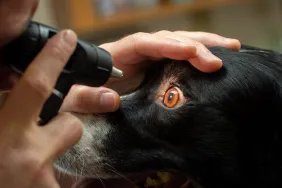Lupus in dogs is a disease in which the immune system attacks the body’s own cells and tissue. There are two types of canine lupus: Systemic lupus erythematosus and discoid lupus erythematosus. They each have different symptoms and treatment options.
The most common form of lupus in dogs is discoid lupus erythematosus (DLE). People sometimes refer to the condition as “Collie nose” or “nasal solar dermatitis,” as it affects the skin, often around the nose and face.
Systemic lupus erythematosus (SLE) is the other form, and it’s a much more serious condition. It can target almost any part of the body, and symptoms will vary depending on the organs that are affected. Often, this can imitate the symptoms of other conditions.
If you see the signs of either form of lupus in your dog, then you must see a veterinarian for proper diagnosis and treatment. Here’s what you should know about the symptoms, causes, diagnosis, and treatment of lupus in dogs.
Symptoms of lupus in dogs

The symptoms of lupus in dogs depend on the type. Symptoms of DLE are typically benign and mostly just affect the skin, while symptoms of SLE can be catastrophic.
Here are a few symptoms you might expect with each type of canine lupus:
Discoid Lupus Erythematosus (DLE)
DLE usually affects the face, nose, lips, mouth, ears, or areas around the eyes. Rarely, it can cause symptoms in the feet or genitals.
Keep an eye out for the following:
- Pale skin on the bridge of the nose
- Redness of the skin, especially the nose, lips, and face
- Scaly, flaky, or crusty skin
- Sores or ulcers
- Scarring
- Pain at the affected sites
- Itchiness or scratching at affected areas
- Bacterial infections
Systemic Lupus Erythematosus (SLE)
SLE can affect almost any area of the body, so symptoms can vary a lot and quickly become life-threatening. SLE is an immune disease where the immune system starts to attack the body’s cells and tissue, and depending on which organs are affected, it can be quite deadly.
Here are a few common symptoms that you might see with SLE:
- Shifting leg lameness
- Arthritis, muscle pain, and stiffness
- Lethargy
- Loss of appetite
- Fever
- Sores or lesions on the skin
- Anemia
- Hair loss
- Swollen lymph nodes
- Mouth ulcers
- Seizures
- Enlarged liver, spleen, or kidneys
- Increased thirst or urination
Causes of lupus in dogs

“Lupus” comes from the Latin word for “wolf.” The disease was named for the rash that appeared on the faces of humans with the disease that looked like a wolf’s bite, though it wasn’t thought to be caused by a wolf’s bite, as some mistakenly believe.
The real causes of lupus are still not well understood, even today. There is likely a genetic component, and exposure to ultraviolet light, stress, medication, and viral infections all contribute to the condition.
Some dogs are more at risk for developing SLE. The disease tends to appear in middle-aged female dogs more frequently.
Certain breeds are also predisposed, including:
- Afghan Hounds
- Beagles
- German Shepherd Dogs
- Irish Setters
- Old English Sheepdogs
- Poodles
- Shetland Sheepdogs
- Rough Collies
Diagnosis of lupus in dogs

You’ll need to see your veterinarian for a proper diagnosis of either form of lupus in your dog.
DLE is usually easier to diagnose, though it can mimic other conditions such as ringworm or nasal lymphoma. Vets begin diagnosis by taking a biopsy of skin from the affected area.
This is a minor procedure, though your dog will need stitches after the sample is taken. It will rule out other causes of symptoms and confirm whether or not your dog has DLE.
SLE is more difficult to diagnose because it can mimic symptoms of so many other conditions based on which organs are affected. Cancer, kidney disease, or poor reaction to medications all have similar symptoms at times to SLE.
Let your vet know about all symptoms you’ve seen in your dog. A blood test will rule out many other causes and help towards diagnosing SLE. Your vet will look for something called antinuclear antibodies in the blood, which are a sign of SLE.
Treatment for lupus in dogs

Treatment for lupus in dogs also depends on the type of lupus, though neither form is curable. This is why treatment focuses on managing symptoms and then continues for the rest of affected dogs’ lives.
DLE is fairly easy to treat, and your vet will focus on healing and controlling any sores, lesions, or ulcers that may appear. Topical steroids are often use to suppress the immune system response and reduce inflammation. Prednisone or other oral steroids might be given until the condition is under control.
Antibiotics and supplements, including Vitamins B and E and Omega-3 fatty acids, may also be given. Pet parents must limit their dogs’ exposure to ultraviolet light, including sunlight, as this worsens the condition.
SLE treatments will vary depending on the affected organs. The goal of treatment is to reduce inflammation and suppress the immune response that is causing damage. NSAIDs, immunosuppressive drugs, or steroids like Prednisone will probably be used.
Chemotherapy can further suppress negative immune system activity and reduce pain. Antibiotics will also be prescribed if there is a secondary infection that needs to be treated. As with DLE, exposure to sunlight must be limited. This treatment must continue for the rest of the dog’s life.
If your vet prescribes medication, then you may want to see if you can can fill the prescription online at Chewy’s pharmacy and have the meds delivered.









